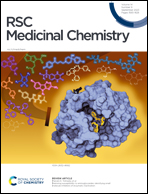Synthesis and antibacterial activity of 2-benzylidene-3-oxobutanamide derivatives against resistant pathogens†
Abstract
Antibiotic resistance evolves naturally through random mutation. Resistance to antimicrobials is an urgent public health crisis that requires coordinated global action. The ESKAPE bacteria (Enterococcus faecium, Staphylococcus aureus, Klebsiella pneumoniae, Acinetobacter baumannii, Pseudomonas aeruginosa, and Enterobacter species) are primarily responsible for the rise in resistant pathogens. There is an immediate requirement to identify a novel molecular scaffold with potent anti-microbial properties. We developed an efficient one-step synthesis of 2-benzylidene-3-oxobutanamide and its derivatives, which allowed the introduction of an α,β-unsaturated ketone moiety in the quest to identify a new molecular scaffold. Seven compounds exhibited very good antibacterial activity in vitro against WHO priority drug-resistant bacteria such as methicillin resistant Staphyloccus aureus (MRSA) and Acinetobacter baumannii-Multi drug resistant (MDR-AB). In cultured human embryonic kidney cells and hemolysis assays, the potent compounds displayed minimal toxicity. These findings suggest that these small molecules with excellent diversity have the potential to combat antibacterial resistance.



 Please wait while we load your content...
Please wait while we load your content...